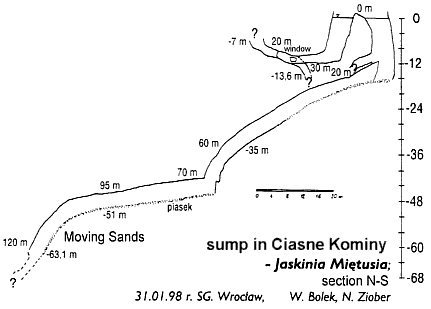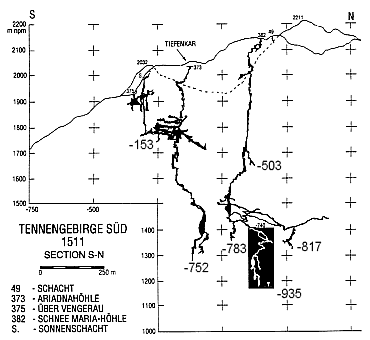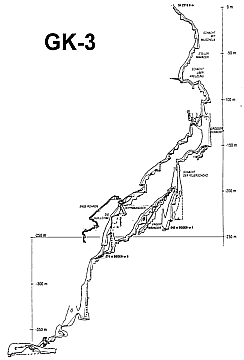


Ciasne Kominy - 1997-98 winter campaign - Wiktor Bolek
Wiktor Bolek reached the depth of -63.1 in the sump in the Ciasne Kominy series (Mietusia cave, the Western Tatra Mts.). It was the deepest diving in polish caves.
During several trips the cave was rigged and parts of diving equipment were transported to
the sump. The diving action was carried out on 31 January. Wiktor Bolek was using nitrox down to -12 m, air as travel mix below -12 m
and trimix as bottom mix, i.e. below -45 m. The sump still continues. The second diver Norbert Ziober - attacked the neighbouring sump. This sump also continues and it seemes
possible to dive it through.
Climbing in Sniezna - Marcin Gala
A team of Warsaw cavers continued climbing in Sniezna cave in the series called Partie Amoku (Amok Series). Several venical chimneys was discovered last year. Three trips were organized this year. Some new vertical chimneys were discovered. The explorers suppose that some of them may lead to new, at present unknown, cave entrances. Total vertical extent of the explored series reached 240 m, with the length of 851 m.
Rumours of diving in Jaskinia Bystra (Bystra Cave) - Gag
Krzysztof Starnawski started diving activity in Bystra Cave (the Western Tatra Mts.). He, with some friends, prepared the diving last year. The main goal is the final, still unexplored V sump. The sump is notorious for the tragic dive in I987, when a Yugoslav caver, Aleksiej Petrujkic died in it. During three expeditions Krzysztof Starnawski covered the distance of about 100 m, with the vertical extent of -28,5 m. He found Petrujkic's breathing equipment after swimming 30 m inside the V sump. The exploration will be continued next winter.

Diving in Jaskinia Zimna (Zimna Cave) - Maciej Tomaszek
In the beginning of last December Krzysztof Starnawski dived in the final, fourth sump in the lower series of Zimna cave. The sump was
previously explored by Wiktor Bolek, who reached a narrow fissure. Starnawski passed through the fissure but stopped 7 m beyond it in front of another very narrow fissure. The total vertical extent of the sump is 9 m.
Canin'97
A five-man Polish team led by Marek Koziol explored the Canin massif (the Julian Alps) in October 1997. A cave labelled AV97?5, and thus called "Point 5" was discovered. The cave reached the depth of about -180 m and still continues.

The Southern Tennengebirge'97 - Marcin Krajewski
A 12-man team from AKG Krakow led by Marcin Krajewski continued exploration in the Tennengebirge. Schnee Maria Höhle and Ariadnahöhle were the main goals of the expedition. In the former cave the exploration was continued in a passage called Meander Ciezkich Butow (Meander of Heavy Boots). The passage was filled with mud, which made exploration more difficult. The passage ends at the head of two parallel vertical pitches. The right pith leads to -935 m, where a meander blocked with boulders is located. The left pitch ends in a narrow squeeze; the passage continues behind it. The discovery of small passages in the chamber called Sala Dezertera was the main effect of exploration in Ariadnahöhle. The expedition also carried out surface exploration. A cave situated in the slopes of Wermutschneit was discovered. The exploration stopped at the depth of -200 m, at the head of a big pitch, which is about I 00 m deep. The team mapped all discovered caves, and, besides, those series, that had not been surveyed during previous expedition.

No success in the Picos - Marek Jedrzejczak
The author describes an expedition to the Western Massif (El Cornion) of the Picos de Europa Mts., which carried out between 27 July and 29 August. Eight cavers from Speleoclub Wroclaw and Speleoklub -Swietokrzyski took part in the expedition. Marek Jedrzejczak, as usual, was the team leader. Some new series were discovered in G-I3 cave. The expedition carried out surface exploration, which brought about discoveries of several small caves. None of them is deeper than 100 m. The most interesting are A-17, A-31, G-19.

Steinernes Meer once again - Maciej Tomaszek
An expedition to the Steinernes Meer (the Salzburger Alps) was again organized by STJ KW Krakow. Maciej Tomaszek led the eight-man team consisting of cavers from STJ KW Krakow, SKTJ and SCC. The main goal was GK-3 cave, but no further discoveries were achieved. But in the previously known cave Frühstickhöhle a narrow squeeze was dug through and a new series situated behind it was discovered. An accident happened during exploration. One of the cavers fell down from the head of 17 m pitch. Fortunately he stopped on the brink of another, unexplored pitch about 40 m deep and was only slightly injured. The cave was not surveyed, but the length of the discovered passages can be estimated as 300 m, with the total vertical extent of -100 m.
Here you can find big version of section.
On the verge of death - Zbigniew Rysiecki
The author describes an accident that happened during exploration in Kammerschanenhöhle (the Göll massif, the Salzburger Alps) at the depth of 200 m and the rescue operation. A caver fell down from the head of 126 m deep pitch. The topography of the pitch head was very complicated. One had to pass through very narrow and diffcult squeeze to reach the start of the descend. The caver's error was the main cause of the accident. Fortunately, as the caver was falling down unconscious, he got entangled in a rope some 30 m lower. After examining his relatively slight injuries the rescue action was organized by expedition members. After 34 hours the injured caver was brought up to the cave entrance.
Caves for tourists in the Aggtelek Karst
The author presents Baradla-barlang - a Hungarian part of the famous Baradla-Domica cave system. Several tours inside this cave are open for tourist all year round.
Ciesec
The presented photographs were taken inside the newly discovered (in spring 1997) cave called Ciesec. The cave is situated in the central part of the Krakow-Wielun Upland. The estimated cave length is 250-300 m with the depth of -23 m.
Long-life anchors in the Tatra caves
- Andrzej Ciszewski KTJ PZA (Caving Commision of Polish Mountaineering Association) have been organizing an operation which is aimed at installing anchors in some Tatra caves. Special anchors called Batinox (a Petzl product) have been used. They were specially lengthened to 17 cm. Until now five caves (Kasprowa Niznia, Czarna - main passage, Ptasia Studnia - old and new bottoms, Nad Dachem, Mietusia) were equipped. Besides Batinoxes were driven in the Prog Mulowy wall on the way to Ptasia Studnia cave.
Exploration of Werteba cave
- Wojciech W. WisniewskiThe author quotes an unknown text written by Bogusz Zygmunt Steczynski in 1870. The text describes exploration of Werteba cave (Podolia, formerly in Poland) which was carried out by Jan Chmielecki, a local leaseholder, in 1822. After digging through the entrance about 500-600 m of cave passages were discovered. Some human bones, bonfire remnants and one silver coin were found. Picture shows the first cave of Podolia map from 1878.

Editors:
Jacek Duleba, Krzysztof Baran, Andrzej Ciszewski, Michal Gradzinski, Piotr
Kulbicki, Wojciech Radecki, Mariusz Szelerewicz
This HTML-version: Dariusz Bartoszewski
Editioral address (main):
ul. Ehrenberga 36a 31-309 Krakow, Poland e-mail: szelerewicz@ceti.pl
Internet edition:
e-mail: dbart@panda.bg.univ.gda.pl
WWW: panda.bg.univ.gda.pl/~dbart
This page was visited
times since 1998.03.07
 |
BACK to index |
 |
EPIMENIDES polish speleo page. |
Last change 1998.03.05